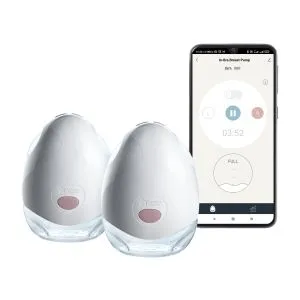How to make up a bottle with breast milk
If you're going to give your baby breast milk in a sterile bottle, you'll need a breast pump (or to be able to express by hand), and some sterile pouches to store your expressed milk in the refrigerator or freezer.
How to make up a bottle with formula
When making a bottle of formula you should always carefully follow the preparation instructions. It's worth noting that too much water can dilute the formula, meaning your baby won't get the optimal amount of nutrition from their feed, and too much formula can lead to constipation and dehydration.
Only make up a formula feed when needed, and make one feed at a time, never in bulk.
Top tips for bottle feeding a baby
Here are some of our top tips to help you bottle feed your baby.
Check the temperature
If your baby likes a warm bottle, you can use an electric bottle warmer to heat their feed, then, use the inside of your wrist to test a few drops before you feed them. If it's a comfortable temperature (not too hot or cold), you're good to go.
While lots of babies like their feeds at body temperature (97–99°F), it's worth noting that not all babies need their milk to be warm. You can try them with cool milk first to see if they'll take it.
Get comfortable
When bottle fed lying down babies can sometimes take too much milk too quickly, so it's important to sit with them in a semi-upright position and support their head so they can swallow and breathe comfortably.
Remember, you should never leave your baby alone to feed with a propped-up bottle as they may choke on the milk.
Introduce the nipple gently
Try brushing your baby's lips with the bottle nipple. This helps to stimulate their gaping or mouth-opening reflex.
Once they've opened their mouth wide, you should let them draw in the nipple at their own pace, just like they would when breastfeeding.
Hold the bottle horizontally
Once the nipple is in your baby's mouth, keep the bottle tipped in a horizontal position so that the milk can flow steadily. Always tilt the bottle so the nipple is full of milk. You'll need to tip it higher as the bottle slowly drains.
This helps prevent them from ingesting air and means that they need to suck actively to get the milk (like they would when breastfeeding).
If you notice that the teat gets blocked and goes flat mid-feed, gently pull on the corner of your baby's mouth to release the latch and replace the old teat with a new sterile one.
Comfort your baby by talking and singing
Bottle feeds are a great time to bond with your baby, and talking and singing to them can be enjoyable and calming for you both.
Follow your baby's cues
Some babies want to feed more often than others, and your baby will let you know how much milk they need. It's best to feed your baby when they seem hungry. This is often called paced bottle feeding. Follow their lead and don't worry if they don't finish their full bottle.
Dispose of any milk your baby doesn't finish
Even though it may seem like a waste, you should discard any unused milk that's left over after a bottle feed. This is because bacteria can get into the milk while your baby is feeding, and if left, this could make them unwell.











